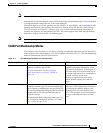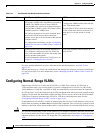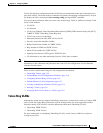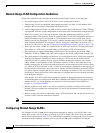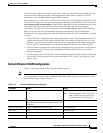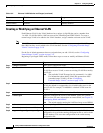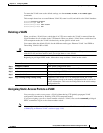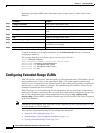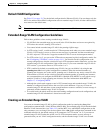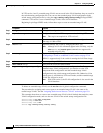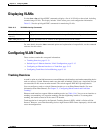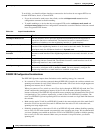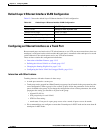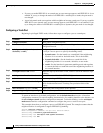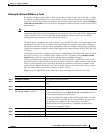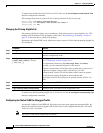
13-11
Catalyst 2960 and 2960-S Switch Software Configuration Guide
OL-8603-09
Chapter 13 Configuring VLANs
Configuring Extended-Range VLANs
Default VLAN Configuration
See Table 13-2 on page 13-7 for the default configuration for Ethernet VLANs. You can change only the
MTU size and the remote SPAN configuration state on extended-range VLANs; all other characteristics
must remain at the default state.
Note The switch must be running the LAN Base image to support remote SPAN.
Extended-Range VLAN Configuration Guidelines
Follow these guidelines when creating extended-range VLANs:
• VLAN IDs in the extended range are not saved in the VLAN database and are not recognized by
VTP unless the switch is running VTP version 3.
• You cannot include extended-range VLANs in the pruning eligible range.
• In VTP version 1 and 2, a switch must be in VTP transparent mode when you create extended-range
VLANs. If VTP mode is server or client, an error message is generated, and the extended-range
VLAN is rejected. VTP version 3 supports extended VLANs in server and transparent modes.
• For VTP version 1 or 2, you can set the VTP mode to transparent in global configuration mode. See
the “Configuring VTP Mode” section on page 14-11. You should save this configuration to the
startup configuration so that the switch boots up in VTP transparent mode. Otherwise, you lose the
extended-range VLAN configuration if the switch resets. If you create extended-range VLANs in
VTP version 3, you cannot convert to VTP version 1 or 2.
• STP is enabled by default on extended-range VLANs, but you can disable it by using the no
spanning-tree vlan vlan-id global configuration command. When the maximum number of
spanning-tree instances are on the switch, spanning tree is disabled on any newly created VLANs.
If the number of VLANs on the switch exceeds the maximum number of spanning-tree instances,
we recommend that you configure the IEEE 802.1s Multiple STP (MSTP) on your switch to map
multiple VLANs to a single spanning-tree instance. For more information about MSTP, see
Chapter 17, “Configuring MSTP.”
• Although the switch stack supports a total of 255 (normal-range and extended-range) VLANs, the
number of configured features affects the use of the switch hardware. If you try to create an
extended-range VLAN and there are not enough hardware resources available, an error message is
generated, and the extended-range VLAN is rejected.
• In a switch stack, the whole stack uses the same running configuration and saved configuration, and
extended-range VLAN information is shared across the stack.
Creating an Extended-Range VLAN
You create an extended-range VLAN in global configuration mode by entering the vlan global
configuration command with a VLAN ID from 1006 to 4094. The extended-range VLAN has the default
Ethernet VLAN characteristics (see Table 13-2) and the MTU size, and RSPAN configuration are the
only parameters you can change. See the description of the vlan global configuration command in the
command reference for the default settings of all parameters. In VTP version 1 or 2, if you enter an
extended-range VLAN ID when the switch is not in VTP transparent mode, an error message is
generated when you exit VLAN configuration mode, and the extended-range VLAN is not created.



